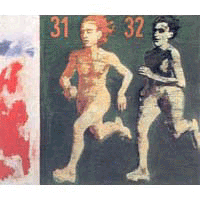![]() When
in the
1960s Jiri Naceradsky
broke
When
in the
1960s Jiri Naceradsky
broke on
to the Czech art scene along with his neo-figurative generation, there appeared
an exceptionally lively and emotive talent, one that seemed continually excited,
its visual assaults inspired by wonder at the world.It soon became clear that
Naceradsky
was an artist who did not overly respect programmes or recommended methods,
and could have been seen more as an augmenter of the expressive traditions
of Czech art; this label was inadequate, however, and Naceradsky, whose work
fundamentally rejected any kind of enclosed system, soon proved it to be invalid.
It is certainly worth mentioning that Naceradsky not only adopted a very free
approach to images of everyday world, but that with his dynamic spirit he
did not hesitate to work with sources of inspiration drawn from the media
and art history. One could possibly perceive in his evocative quotations of
other works of art the emerging features of what was to be the "post-"era.Jiri
Naceradsky
always saw everything that exists as an offer and challenge to
attempt a new issue.
on
to the Czech art scene along with his neo-figurative generation, there appeared
an exceptionally lively and emotive talent, one that seemed continually excited,
its visual assaults inspired by wonder at the world.It soon became clear that
Naceradsky
was an artist who did not overly respect programmes or recommended methods,
and could have been seen more as an augmenter of the expressive traditions
of Czech art; this label was inadequate, however, and Naceradsky, whose work
fundamentally rejected any kind of enclosed system, soon proved it to be invalid.
It is certainly worth mentioning that Naceradsky not only adopted a very free
approach to images of everyday world, but that with his dynamic spirit he
did not hesitate to work with sources of inspiration drawn from the media
and art history. One could possibly perceive in his evocative quotations of
other works of art the emerging features of what was to be the "post-"era.Jiri
Naceradsky
always saw everything that exists as an offer and challenge to
attempt a new issue.
Naceradsky's permanent effort to raise questions free of clichés began in the 1960s in a grimacing, aggresive and mocking way, with broad painterly expression and an expressive and structured paint substance. However it also featured an inner pang at the loss of balance and measure, which in the European tradition mirrored the fullness of divine permanency. This carefully measured quolity expressing stability always had its basis in proportions conveyed through geometry.
